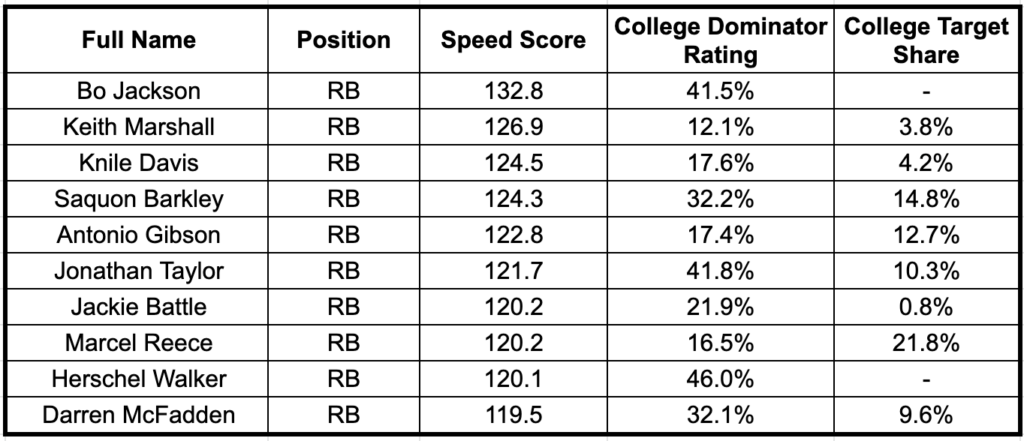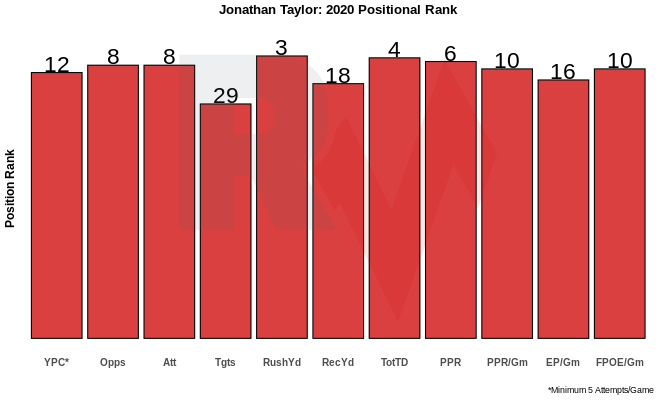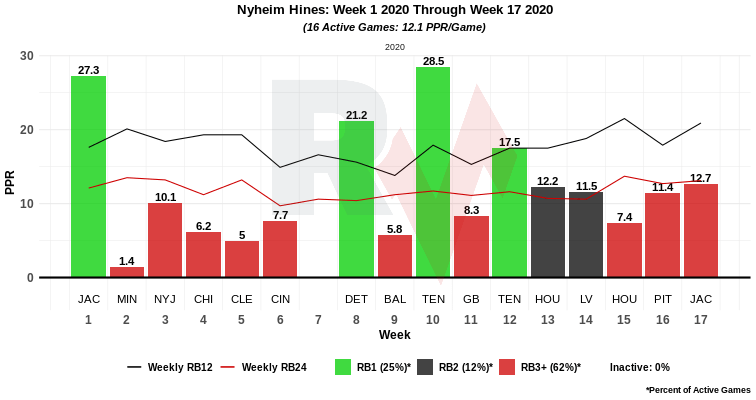Remain calm about the Colts’ injuries because their star running back can still finish as a fantasy RB1. With foot injuries to Carson Wentz and All-Pro left guard Quenton Nelson, Jonathan Taylor‘s ADP dropped from a first-round pick to an Underdog ADP nearing the middle of the second round. However, I’ll provide data to back up why Taylor can still finish as an RB1 in 2021.
Is his situation much different from 2020 with Wentz versus Philip Rivers? Taylor provided efficient production on the ground last season, but can he replicate that and add in receiving work? We’ll answer those questions and more to help us decide whether we should value him as an RB1 in 2021.
Is Jonathan Taylor Still An RB1?
As noted earlier, Jonathan Taylor‘s ADP has dropped to 15.6 on Underdog as RB10 after sitting in the middle of the first round. Currently, Taylor goes near Nick Chubb, Antonio Gibson, and D.K. Metcalf. It makes sense to see his ADP fall given the reports of losing the Colts’ new starting quarterback and their All-Pro left guard.
Elite & Efficient Prospect
As an elite prospect, Jonathan Taylor boasted a 121.7 (99th-percentile among qualified running backs) Speed Scorebehind Saquon Barkley and Antonio Gibson, with a 41.8-percent (92nd-percentile) College Dominator Rating.
Last season, the Colts averaged 28.7 (No. 10) Team Run Plays Per Game with a +1.48 (No. 9) Game Script. With an emphasis on the run game paired with a positive Game Script, Jonathan Taylor earned 203.6 (No. 11) Weighted Opportunities. Although some may think the Colts used him primarily as a runner, they gave him an 8.3-percent (No. 30) Target Share.
https://www.youtube.com/watch?v=_fff6PxuR_0
Taylor provided efficient production, evidenced by his 5.5 (No. 14) Yards Per Touch and +12.2 (No. 15) Production Premium. Although his 1.14 (No. 38) Yards Created Per Touch don’t wow us, we’ll note his offensive line helped him with a 92.3 (No. 4) Run Blocking Efficiency. Meanwhile, Taylor ranked No. 17 with 305 Yards Created and No. 10 with 64 Evaded Tackles, so he showed the ability to create yards by himself.
Earlier in the offseason, I wrote a Meet the Metric article breaking downRun Blocking Efficiency. In that piece, I noted other stats and metrics to consider with RBE, including Yards Per Carry and Yards Created Per Touch. That said, thankfully, Taylor ended up with both a quality offensive line and a high YPC rank, yet a lower Yards Created Per Touch average.
An Efficient Receiver
Don’t forget thatJonathan Taylorproved he’s an efficient receiver, with 8.3 (No. 6) Yards Per Reception and 1.57 (No. 8) Yards Per Route Run amongst qualified running backs. We have even more data to back up his efficiency. Last season, he ranked No. 8 with 36.5 Rushing Fantasy Points Over Expectation (FPOE). He also finished with a 6.8 Receiving FPOE per RotoViz. The only running backs that ranked highly in rushing FPOE with a higher receiving FPOE are Dalvin Cook and Alvin Kamara. If Taylor’s receiving efficiency improves, then he can have a career-best season in year two.
But, What About Nyheim Hines?
It’s often a smart strategy to fade a primarily pass-catching running back after one of their best seasons. However, fantasy managers improve and adapt every season, so Nyheim Hines‘ ADP sits at RB45 at pick 146.0 on Underdog. Last season, it often felt like playing whack a mole trying to figure out when to start Hines. He would come off a blowup game, then follow that up with a dud. Or you could have possibly kept him in your lineup all season with those highs and lows.
In 2020, Hines garnered 77 (No. 3) targets with 174.3 (No. 19) Weighted Opportunities and produced 64 (No. 3) receptions and 482 (No. 3) Receiving Yards. He earned a 14.4-percent (No. 6) Target Share and averaged 7.5 (No. 18) Yards Per Reception. Hines boasted an uber-efficient season relying on receiving volume, evidenced by his 5.6 (No. 8) Yards Per Touch and +24.4 (No. 5) Production Premium.
Past Pass-Catching Running Back Seasons
Several notable primarily pass-catching running backs come to mind that followed up a productive fantasy season with a lesser version of that. These backs includeTarik Cohen(2018), James White (2018), and Danny Woodheadtwice in 2013 and 2015. For Woodhead, he’s an outlier because he missed time due to injuries the following two seasons in 2014 and 2016. The following two seasons, he only played in five combined games.
Meanwhile, in 2018, Cohen hauled in 71 receptions for 725 receiving yards, logging a similar 79 receptions in 2019 with only 456 receiving yards. Cohen ranked No. 15 with 14.6 Fantasy Points Per Game in 2018, then 10.2 (No. 37) FPPG in 2019. Oddly, 2018 looked like the year of the pass-catching running back. That season (2018), James White ranked No. 10 with 17.3 FFPG and dropped to No. 23 with 13.3 FPPG the following season.
In 2021, the two concerning backs include Nyheim Hines and J.D. McKissic. With McKissic, he set career-highs across the board after garnering 110 (No. 1) Targets, 80 (No. 2) Receptions, and 589 (No. 2) Receiving Yards. Jonathan Taylor‘s receiving skills will take away from Hines’ pass-catching opportunities in 2021, or it’s at least within the range of outcomes.
Carson Wentzwon’t pepper his running backs like Philip Rivers did. In the past three seasons, Rivers targeted the top two backs on their team with the following Target Shares.
2020: 23.8-percent Target Share to Top-2 RB
2019: 27.8-percent Target Share to Top-2 RB
2018: 23.4-percent Target Share to Top-2 RB
Meanwhile, Wentz targeted his running backs a bit less.
2020: 20.1-percent Target Share to Top-2 RB
2019: 14.7-percent Target Share to Top-2 RB
2018: 20.7-percent Target Share to Top-3 RB (included injured Darren Sproles)
All that said, couldn’t this mean it’s a negative point regarding Taylor’s receiving volume? Possibly, but if we assume the running back Target Share drops with a shift to Taylor from Hines, that’s still a boost for Taylor.
But, What About Carson Wentz’s Injury?
Last season, old man Philip Riversled a team that averaged 35.9 (No. 23) Team Pass Plays Per Game with their run-heavy approach. As much as we joke about Rivers’ passing ability, he ranked No. 11 with 7.4 Adjusted Yards Per Attemptand No. 2 with a 99.2-percent True Completion Percentage. He showed extreme accuracy and efficiency, but ranked middle of the pack with a -2.6 (No. 17) Production Premium.
It’s hard to compare Carson Wentz‘s 2020 season since the entire Eagles offense struggled due to injuries. However, he averaged 4.6 (No. 37) AY/A last season with a 6.6 (No. 17) AY/A in 2019. The improved pass protection should help, evidenced by his 82.0-percent (No. 29) Protection Rate in 2020 compared to the 91.0-percent (No. 3) Protection Rate for Rivers. Wentz ranked No. 24 with a -7.8 Production Premium in 2020, and No. 21 with a -5.0 mark in 2019.
Overall takeaway: Wentz isn’t a significant upgrade to Rivers. Sure, the offensive line should help Wentz, but the Eagles arguably have better pass-catching weapons outside of the running backs.
Conclusion
The World Famous Draft Kit ranks Jonathan Taylor at No. 19 overall as RB12 in PPR leagues. That just about falls in line with his Underdog ADP near pick 15.0 and RB10. Although his round one ADP was probably too high, it’s hard to pass up a player with his talent in the second round. Depending on your draft slot, he is a perfect first or second running back to target in 2021 with RB1 upside.
As noted earlier, Taylor displayed the ability to provide efficient production in the rushing and receiving game. He ranked inside the top-8 in rushing FPOE. Amongst those eight backs, only two finished with a higher receiving efficiency: Alvin Kamaraand Dalvin Cook. Expect Taylor’s receiving efficiency to improve in 2021, which could translate into a near career-best season. Quenton Nelsonand Carson Wentz should return sometime during the season, but Nelson looks like the most helpful piece.
I already learned this before – don’t fade efficient and talented players with paths to volume like Jonathan Taylor.















